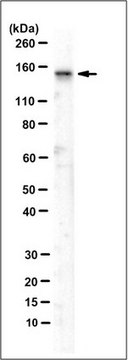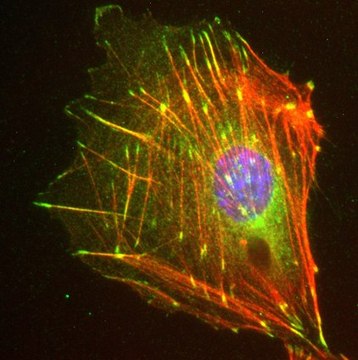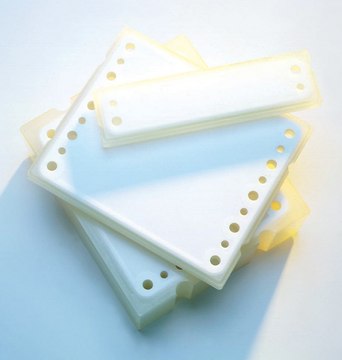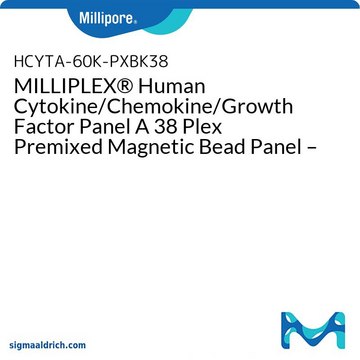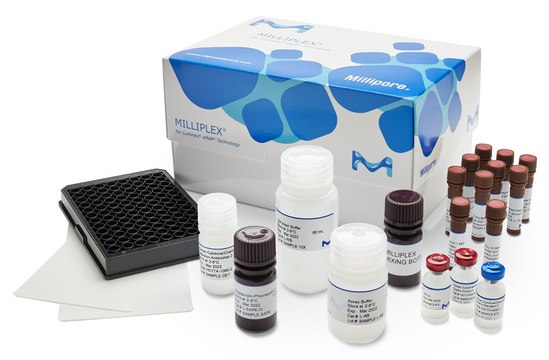MABE990
Anti-MSL-2 Antibody, clone 10C3.1
clone 10C3.1, from mouse
Synonym(s):
E3 ubiquitin-protein ligase MSL2, Male-specific lethal-2 homolog, Male-specific lethal-2 homolog 1, Male-specific lethal 2-like 1, MSL-2, MSL2-like 1, RING finger protein 184
Sign Into View Organizational & Contract Pricing
Select a Size
All Photos(3)
Select a Size
Change View
About This Item
UNSPSC Code:
12352203
eCl@ss:
32160702
NACRES:
NA.41
Recommended Products
General description
E3 ubiquitin-protein ligase MSL2 (UniProt Q9HCI7; also known as Male-specific lethal-2 homolog, Male-specific lethal-2 homolog 1, Male-specific lethal 2-like 1, MSL-2, MSL2-like 1, RING finger protein 184) is encoded by the MSL2 (also known as KIAA1585, MSL2L1, RNF184) gene (Gene ID 55167) in human. MSL2 (male-specific lethal 2) was originally identified in Drosophila and characterized as a gene whose mution causes male-specific lethality. Human MSL (hMSL) orthologues are found in an evolutionary conserved complex known as the hMOF (Males absent on the first, human) complex that is composed of hMOF, hMSL1, hMSL2, hMSL3, and Nucleoprotein 153 (NUP153). MSL2 is a RING domain-containing E3 ligase that targets the tumor suppressor p53 Lys351 for monoubiquitination, exposing a nuclear export motif within p53 as well as releasing p53 from MDM2. MSL2 overexpression causes an upregulation of mitochondrial-dependent apoptosis as a result of p53 cytoplasmic accumulation. hMSL1/hMSL2 heterodimer is reported to ubiquitinate histone H2B on Lys34 (H2BK34ub), which promotes transcription activation by stimulating the activities of MLL/SET1 family H3K4 methyltransferases and the H3K79 methyltransferase DOT1L. In addition, both hMSL1 and hMOF are reported to be modified by hMSL2 following DNA damage induction, and hMSL2-depletion causes impaired non-homologous end joining (NHEJ) repair in human cells.
Specificity
Expected to react with both spliced isoforms of human MSL2 reported by UniProt (Q9HCI7).
Immunogen
Epitope: Internal (C-terminal half).
GST-tagged recombinant human MSL-2 C-terminal fragment.
Application
Anti-MSL-2 Antibody, clone 10C3.1 is an antibody against MSL-2 for use in Western Blotting, Immunocytochemistry.
Research Category
Epigenetics & Nuclear Function
Epigenetics & Nuclear Function
Research Sub Category
Ubiquitin & Ubiquitin Metabolism
Ubiquitin & Ubiquitin Metabolism
Western Blotting Analysis: 2.0 µg/mL of this antibody detected MSL-2 in 10 µg of HepG2 and HEK293 cell lysates.
Immunocytochemistry Analysis: A 1:200 dilution from a representative lot detected MSL-2 in HUVECs, A431 and HeLa cells.
Immunocytochemistry Analysis: A 1:200 dilution from a representative lot detected MSL-2 in HUVECs, A431 and HeLa cells.
Quality
Evaluated by Western Blotting in LNCaP cell lysate.
Western Blotting Analysis: 2.0 µg/mL of this antibody detected MSL-2 in 10 µg of LNCaP cell lysate.
Western Blotting Analysis: 2.0 µg/mL of this antibody detected MSL-2 in 10 µg of LNCaP cell lysate.
Target description
~62 kDa observed. 62.54 kDa (isoform 1) and 54.34 kDa (isoform 2) calculated. Uncharacterized band(s) may appear in some lysates.
Physical form
Format: Purified
Protein G Purified
Purified mouse monoclonal IgG1κ in buffer containing 0.1 M Tris-Glycine (pH 7.4), 150 mM NaCl with 0.05% sodium azide.
Storage and Stability
Stable for 1 year at 2-8°C from date of receipt.
Other Notes
Concentration: Please refer to lot specific datasheet.
Disclaimer
Unless otherwise stated in our catalog or other company documentation accompanying the product(s), our products are intended for research use only and are not to be used for any other purpose, which includes but is not limited to, unauthorized commercial uses, in vitro diagnostic uses, ex vivo or in vivo therapeutic uses or any type of consumption or application to humans or animals.
Not finding the right product?
Try our Product Selector Tool.
Storage Class
12 - Non Combustible Liquids
wgk_germany
WGK 1
Certificates of Analysis (COA)
Search for Certificates of Analysis (COA) by entering the products Lot/Batch Number. Lot and Batch Numbers can be found on a product’s label following the words ‘Lot’ or ‘Batch’.
Already Own This Product?
Find documentation for the products that you have recently purchased in the Document Library.
Our team of scientists has experience in all areas of research including Life Science, Material Science, Chemical Synthesis, Chromatography, Analytical and many others.
Contact Technical Service
